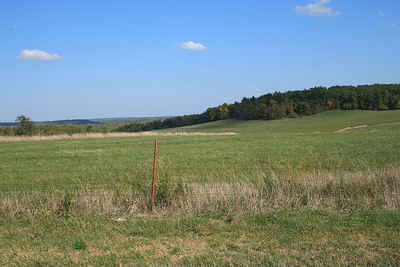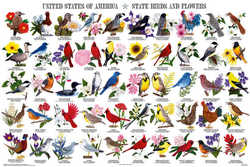
Missouri Symbols
Missouri State Game Bird
Bobwhite Quail (partridge)

(Colinus virginianus)
Adopted on July 13, 2007.
Adoption of the bobwhite quail, (Colinus virginianus,) as Missouri's official game bird was prompted by Quail Unlimited, a national group "founded in 1981 to battle the problem of dwindling populations and wildlife habitat and is dedicated to the wise management of America's wild quail."
In 2006, an attempt to make the quail an official symbol of the state was passed in the Missouri House of Representatives, but failed to pass in the Senate.
With much better luck in 2007. House Bill No. 576, introduced by Representatives Coope, Wright, Wilson, Schad, Hunter, Sater, Stevenson, Wallace, Weter, Moore, Funderburk and Dougherty, was passed by both houses of the Missouri General Assembly and, on July 13, 2007, it was signed into law by Governor Matt Blunt.
The emphatic, whistled bob-white ringing from a grassy field or piney woods has long been a characteristic sound of summers in the Eastern countryside and is in fact the bobwhite quail is the state game bird of Missouri, Georgia, and Tennessee.
Missouri State Game Bird: Bobwhite

The bobwhite, also known as the partridge, is considered one of the finest game birds in the world. It is a short-tailed chunky brown bird, usually 8 to 10 inches long. The male has a white throat and a white stripe above the eye, while the female has a buffy throat and eye stripe. In spring the male's clearly whistled bob white is answered by the female's four-syllable whistle. This game bird lays from 10 to 20 pure white eggs, more than almost any other bird.
The bird is about 24 cm in length and is generally red-brown in appearance with black and tawny markings. The male has a white throat and eyebrow. The hen is similar in appearance, but her throat and eyebrow is buff and her overall color is somewhat lighter.
Characteristics of the Bobwhite
Food Habits
This bird eats seeds, fruits, grasses, grains, corn, acorns and insects. The diet consists primarily of seeds but also includes green leafy material,
fruits and, invertebrates. Approximately 85% of the diet is vegetation and 15% animal matter. However, the relative quantity of each is seasonal (Ehrlich,
et al 1988).
In early spring, leafy material is an important source of vitamins. Insects are important from spring until autumn; during these months they may constitue
a quarter of the diet. Females consume more insects than males in response to elevated need for protein during egg laying. Fruits are also an important
summer source of carbohydrates. Seeds and legumes constitute the majority of the bobwhite diet in fall and winter. Hatchlings are completely dependent
on insects as a food source (Landers and Mueller 1986).
Call, Behaviour
The bird gives a clear whistled bob-WHITE or poor-bob-WHITE call. Bobwhite Quail are sedentary. After the breeding season they live together in a covey of up to 30 individuals, huddling together at night and in cold weather. When danger threatens, the birds fly out in all directions, startling the would-be predator, who often catches none of the quail.
Habitat
Woodlands, open country with brush and weeds, grasslands, croplands and roadsides.
Life Cycle
The breeding season begins in mid-April, peaks in May and June, and extends into September. Found in the grass, the nest is a depression lined with fine grass. The female usually lays 12-16 eggs (range, 6-28). Both adults incubate the eggs for 23-24 days, and care for the precocial young for 6-7 days after they hatch. The young are able to capture food themselves after approximately 7 days. The family group stays together with the covey, a group of 2 or more families of Bobwhite.
Natural Distribution
The Bobwhite Quail is native to northern and central America from southern Ontario in south-eastern Canada, central and eastern USA to eastern Mexico,
Guatemala, Cuba and the Isle of Pines.
The quail is thought to be locally common and was once a popular game bird in the southern states of the USA, but numbers and range have been reduced
by agriculture. Fortunately, bobwhite quail do not move much and are very adaptable. This has allowed landowners to effectively manage the birds on
relatively small tracts of land
Missouri Law
The law designating the bobwhite quail as the official Missouri state game bird is SECTION 10.012 of the Missouri Revised Statutes, Title 2 (SOVEREIGNTY, JURISDICTION AND EMBLEMS) Chapter 10 (State Emblems) Section 10.012
TITLE II SOVEREIGNTY, JURISDICTION AND EMBLEMS
CHAPTER 10 STATE EMBLEMS
SECTION 10.012
Bobwhite quail, official state game bird.
10.012. The "bobwhite quail" (Colinus virginianus) is selected for and shall be known as the official game bird of the state of
Missouri.
(L. 2007 H.B. 576)
Taxonomic Hierarchy: Bobwhite Quail
Kingdom: Animalia - animals
Phylum: Chordata - chordates
Subphylum: Vertebrata - vertebrates
Class: Aves - birds
Order: Galliformes
Family: Odontophoridae
Genus: Colinus
Species: Colinus virginianus







